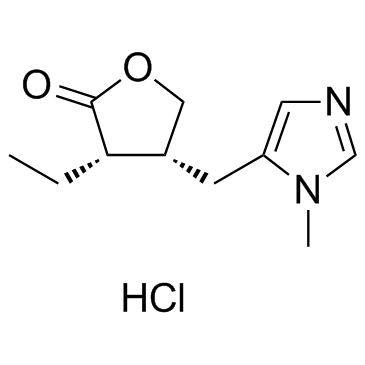Pilocarpine Hydrochloride

Pilocarpine Hydrochloride structure
|
Common Name | Pilocarpine Hydrochloride | ||
|---|---|---|---|---|
| CAS Number | 54-71-7 | Molecular Weight | 208.257 | |
| Density | 1.2±0.1 g/cm3 | Boiling Point | 431.8±18.0 °C at 760 mmHg | |
| Molecular Formula | C11H17ClN2O2 | Melting Point | 202-205 °C(lit.) | |
| MSDS | Chinese USA | Flash Point | 215.0±21.2 °C | |
| Symbol |

GHS06 |
Signal Word | Danger | |
|
Chemical genetics reveals a complex functional ground state of neural stem cells.
Nat. Chem. Biol. 3(5) , 268-273, (2007) The identification of self-renewing and multipotent neural stem cells (NSCs) in the mammalian brain holds promise for the treatment of neurological diseases and has yielded new insight into brain cancer. However, the complete repertoire of signaling pathways ... |
|
|
Function of inhibitory micronetworks is spared by Na+ channel-acting anticonvulsant drugs.
J. Neurosci. 34(29) , 9720-35, (2014) The mechanisms of action of many CNS drugs have been studied extensively on the level of their target proteins, but the effects of these compounds on the level of complex CNS networks that are composed of different types of excitatory and inhibitory neurons a... |
|
|
Development and characterization of pilocarpine loaded Eudragit nanosuspensions for ocular drug delivery.
J. Biomed. Nanotechnol. 9(1) , 124-31, (2013) With aim of improving the availability of drug at intraocular level and to reduce the frequency of drug administration, pilocarpine nitrate nanosuspensions were made from inert polymer resin (Eudragit RL 100) with varying drug to polymer ratios using Lutrol F... |
|
|
Pramipexole reduces parkinsonian tremor induced by pilocarpine infusion in the rat striatum.
Pharmacol. Biochem. Behav. 131 , 1-5, (2015) Pramipexole is widely prescribed for the treatment of Parkinson's disease. This dopamine (DA) receptor agonist has a higher affinity for D3 over D2 receptors. We compared the effect of pramipexole to apomorphine, a non-specific DA receptor agonist, on the sup... |
|
|
Benzodiazepines induce sequelae in immature mice with inflammation-induced status epilepticus.
Epilepsy Behav. 52 , 180-6, (2015) Since benzodiazepines (BZPs) became clinically available for the treatment of status epilepticus (SE) in children, the incidence of neurological sequelae has increased. However, the cause-effect relationship is poorly understood. In this paper, we examined th... |
|
|
Long-term seizure suppression and optogenetic analyses of synaptic connectivity in epileptic mice with hippocampal grafts of GABAergic interneurons.
J. Neurosci. 34(40) , 13492-504, (2014) Studies in rodent epilepsy models suggest that GABAergic interneuron progenitor grafts can reduce hyperexcitability and seizures in temporal lobe epilepsy (TLE). Although integration of the transplanted cells has been proposed as the underlying mechanism for ... |
|
|
Sucrose consumption test reveals pharmacoresistant depression-associated behavior in two mouse models of temporal lobe epilepsy.
Exp. Neurol. 263 , 263-71, (2015) Among the comorbidities observed in epilepsy patients depression is the most frequent one. Likewise, depression by itself is accompanied by an increased risk to develop epilepsy. Both epilepsy and depression are characterized by a high incidence of pharmacore... |
|
|
proBDNF and p75NTR Control Excitability and Persistent Firing of Cortical Pyramidal Neurons.
J. Neurosci. 35 , 9741-53, (2015) Persistent firing of entorhinal cortex (EC) pyramidal neurons is a key component of working and spatial memory. We report here that a pro-brain-derived neurotrophic factor (proBDNF)-dependent p75NTR signaling pathway plays a major role in excitability and per... |
|
|
Impaired neuronal operation through aberrant intrinsic plasticity in epilepsy.
Ann. Neurol. 77(4) , 592-606, (2015) Patients with temporal lobe epilepsy often display cognitive comorbidity with recurrent seizures. However, the cellular mechanisms underlying the impairment of neuronal information processing remain poorly understood in temporal lobe epilepsy. Within the hipp... |
|
|
Regulation of the perilymphatic-endolymphatic water shunt in the cochlea by membrane translocation of aquaporin-5.
Pflugers Arch. 467 , 2571-88, (2015) Volume homeostasis of the cochlear endolymph depends on radial and longitudinal endolymph movements (LEMs). LEMs measured in vivo have been exclusively recognized under physiologically challenging conditions, such as experimentally induced alterations of peri... |